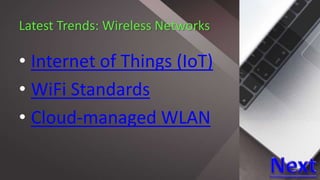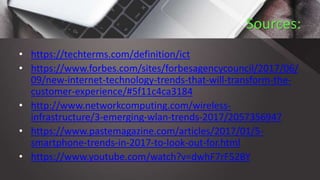Week3 lec6 ict
- 1. Information and Communication Technology (ICT) Weeks 3: Lecture 6
- 2. What is ICT? • Stands for "Information and Communication Technologies." • ICT refers to technologies that provide access to information through telecommunications. • It is similar to Information Technology (IT), but focuses primarily on communication technologies. • This includes the Internet, wireless networks, cell phones, and other communication mediums.
- 3. Examples of ICT provided to Society to Communicate (past few decades ago) • Instant messaging, Voice over IP (VoIP), video conferencing • Allows people to communicate real- time with others in different countries.
- 4. Examples of ICT provided to Society to Communicate (past few decades ago) • Social networking websites like Facebook, Twitter, Instagram • Allow users from all over the world to remain in contact and communicate in regular basis.
- 5. Modern ICT Created a "global village," in which people can communicate with others across the world as if they were living next door.
- 6. Latest Trends: Internet • Conversational Web • Convergence Of Social Media, Influencer Marketing And E- Commerce • Internet Of Things, Data And Analytics
- 7. Conversational Web The conversational web is all about expanding the way we interface and interact with the web.
- 8. Conversational Web: Examples • Chatbots (text) – Healthcare: Babylon Health, Symptomate, Florence – Business: Reserve, FoodBot, Chip • Virtual Assistants (voice) – Apple’s Siri, Amazon’s Alexa, Microsoft’s Cortana, Samsung’s Bixby • Botnik (encompass all conversational interfaces such as voice, biometrics, augmented reality, virtual reality, and some other forms of reality yet to be defined — including, one day, perhaps, a direct interface to the human brain)
- 9. Convergence Of Social Media, Influencer Marketing And E-Commerce Social media is changing the way we receive our information. We now have influencers on social media who are passionate about specific topics and have created a significant following on social networks. These people have a greater-than-average share of voice within a certain market segment and brands are leveraging them to promote products. http://primer.com.ph/blog/2017/04/11/filipino-social- media-stars-win-big-at-influence-asia-2017/
- 10. Internet Of Things (IoT), Data And Analytics Data from IoT connected devices will be used to gain more insight from lifestyle habits so that marketers can build personalized shopping experiences and more importantly, create a seamless, omni channel shopping experience between online and brick and mortar properties. Ingestible Sensors Depression-Fighting Apple Watch
- 11. Latest Trends: Wireless Networks • Internet of Things (IoT) • WiFi Standards • Cloud-managed WLAN
- 12. Internet of Things (IoT) • IHS (Information Handling Services) forecasts that the installed base of IoT devices will grow from 15.4 billion in 2015 to 30.7 billion in 2020. • Dell 'Oro Group estimates an installed base of nearly 1 billion WLAN network devices by 2020 and expects these WLAN devices will be the primary way most IoT devices connect to networks.
- 13. WiFi Standards • The first 802.11ac Wave 2 access point was released in April 2015, and since then there's been a steady stream of Wave 2 APs hitting the market. • Wave 2 brings the benefit of MU- MIMO (Multi-User Multi-Input and Multi-Output) and the ability to service up to three concurrent streams to different users.
- 14. Cloud-Managed WLAN • With a Cloud-Managed WLAN, Aps (Access Points) connect to a virtual controller, typically located in a public cloud on the Internet. • Control-plane information, AP management and other WLAN services are performed between the cloud controller and the local APs across an Internet connection
- 15. Latest Trends: Cellphones / Smartphones • Headphone Jacks • 18:9 Aspect Ratio • Digital Assistants • Dual Cameras • Buttons Be Gone
- 16. Headphone Jacks • Apple’s decision to remove the headphone jack, send reverberations throughout the industry. • In 2016, phones like the Moto Z and the iPhone 7 switch over completely to digital and wireless audio. • Phones like the Galaxy S8 and the iPhone 8 will be without headphone jacks. • In addition Android phones will moving to USB-C ports. USB-C Port
- 17. 18:9 Aspect Ratio • LG’s G6 is the first phone with an 18:9 (or 2:1) aspect ratio (Univisium). • Most phones have a 16:9 aspect ratio. • This means the phone will be a bit taller than normal—and maybe even a bit better for one-handed usage. LG G6 Samsung S8+
- 18. Digital Assistants • “Smarter AI” is pretty much always on the docket for a smartphone manufacturer. • Samsung and Apple double down on machine learning and better digital assistants. Demo: Bixby Vs. Siri
- 19. Dual Cameras • LG and Huawei led the way in 2016 with its dual camera setups. Apple followed suit later in the year. • In 2017, the rest of the smartphones released have similar dual-cameras on their backs. • The iPhone’s dual-camera is used to both to create a bokeh effect and for an analogue zoom. • Bokeh effect is the aesthetic quality of the blur produced in the out-of- focus parts of an image produced by a lens.
- 20. Buttons Be Gone • iPhone 8 and the Galaxy S8 use smaller bezels, and bigger screens. • The size of the home button has made the iPhone’s jump to big screens particularly awkward. • But this year Apple is looking to fix that problem, iPhone 8 will get rid of the home button in favor of a smaller phone with a bigger screen. Iphone 8
- 21. Sources: • https://techterms.com/definition/ict • https://www.forbes.com/sites/forbesagencycouncil/2017/06/ 09/new-internet-technology-trends-that-will-transform-the- customer-experience/#5f11c4ca3184 • http://www.networkcomputing.com/wireless- infrastructure/3-emerging-wlan-trends-2017/2057356947 • https://www.pastemagazine.com/articles/2017/01/5- smartphone-trends-in-2017-to-look-out-for.html • https://www.youtube.com/watch?v=dwhF7rF52BY




















